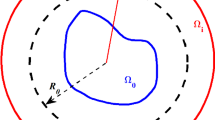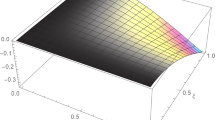Abstract
For a singularly perturbed reaction–diffusion–advection equation, called in applications a Burgers-type equation and having a time-periodic solution with an internal transition layer, asymptotic analysis is used to solve some inverse problems of reconstructing model parameters (determining the linear amplification factor and boundary conditions) from known information about the observed solution of the direct problem in a given time interval (period). Numerical experiments demonstrating the efficiency of the approach proposed are conducted.



Similar content being viewed by others
REFERENCES
N. Nefedov, “Comparison principle for reaction–diffusion–advection problems with boundary and internal layers,” Lect. Notes Comput. Sci. 8236, 62–72 (2013).
J. M. Burgers, “A mathematical model illustrating the theory of turbulence,” Adv. Appl. Mech. 1, 171–199 (1948).
A. Parker, “On the periodic solution of the Burgers equation: A unified approach,” Proc. R. Soc. London Ser. A 438, 113–132 (1992).
J. D. Cole, “On a quasilinear parabolic equation occurring in aerodynamics,” Q. Appl. Math. 9, 225–236 (1951).
W. Malfliet, “Approximate solution of the damped Burgers equation,” J. Phys. A: Math. Gen. 26, 723–728 (1993).
E. S. Fahmy, K. R. Raslan, and H. A. Abdusalam, “On the exact and numerical solution of the time-delayed Burgers equation,” Int. J. Comput. Math. 85 (11), 1637–1648 (2008).
O. V. Rudenko, S. N. Gurbatov, and C. M. Hedberg, Nonlinear Acoustics through Problems and Examples (Trafford, Victoria, BC, Canada, 2011).
O. V. Rudenko, “Equation admitting linearization and describing waves in dissipative media with modular, quadratic, and quadratically cubic nonlinearities,” Dokl. Math. 94 (3), 703–707 (2016).
O. V. Rudenko, “Modular solitons,” Dokl. Math. 94 (3), 708–711 (2016).
N. N. Nefedov and O. V. Rudenko, “On front motion in a Burgers-type equation with quadratic and modular nonlinearity and nonlinear amplification,” Dokl. Math. 97 (1), 99–103 (2018).
N. Nefedov, L. Recke, and K. Schneider, “Existence and asymptotic stability of periodic solutions with an interior layer of reaction–advection–diffusion equations,” J. Math. Anal. Appl. 405 (1), 90–103 (2013).
E. A. Antipov, V. T. Volkov, N. T. Levashova, and N. N. Nefedov, “A solution of moving front type for a two-dimensional reaction-diffusion problem,” Model. Anal. Inf. Syst. 24 (3), 259–279 (2017).
D. Lukyanenko, N. Nefedov, E. Nikulin, and V. Volkov, “Use of asymptotics for new dynamic adapted mesh construction for periodic solutions with an interior layer of reaction–diffusion–advection equations,” Lect. Notes Comput. Sci. 10187, 107–118 (2017).
E. A. Antipov, N. T. Levashova, and N. N. Nefedov, “Asymptotics of the front motion in the reaction–diffusion–advection problem,” Comput. Math. Math. Phys. 54 (10), 1536–1549 (2014).
V. Volkov, D. Lukyanenko, and N. Nefedov, “Asymptotic-numerical method for the location and dynamics of internal layers in singular perturbed parabolic problems,” Lect. Notes Comput. Sci. 10187, 721–729 (2017).
S. I. Kabanikhin, “Definitions and examples of inverse and ill-posed problems,” J. Inverse Ill-Posed Probl. 16 (4), 317–357 (2008).
M. I. Belishev, “Boundary control in reconstruction of manifolds and metrics (the BC method),” Inverse Probl. 12 (5), 1–45 (1997).
L. Beilina and M. V. Klibanov, “A globally convergent numerical method for a coefficient inverse problem,” SIAM J. Sci. Comput. 31 (1), 478–509 (2008).
S. I. Kabanikhin, K. K. Sabelfeld, N. S. Novikov, and M. A. Shishlenin, “Numerical solution of an inverse problem of coefficient recovering for a wave equation by a stochastic projection methods,” Monte Carlo Methods Appl. 21 (3), 189–203 (2015).
D. Lukyanenko, M. Shishlenin, and V. Volkov, “Solving of the coefficient inverse problems for a nonlinear singularly perturbed reaction–diffusion–advection equation with the final time data,” Commun. Nonlinear Sci. Numer. Simul. 54, 233–247 (2018).
V. T. Volkov, D. V. Lukyanenko, and N. N. Nefedov, “Analytical-numerical approach to describing time-periodic motion of fronts in singularly perturbed reaction–advection–diffusion models,” Comput. Math. Math. Phys. 59 (1), 46–58 (2019).
D. V. Lukyanenko, V. T. Volkov, and N. N. Nefedov, “Dynamically adapted mesh construction for the efficient numerical solution of a singular perturbed reaction–diffusion–advection equation,” Model. Anal. Inf. Syst. 24 (3), 322–338 (2017).
D. Lukyanenko, N. Nefedov, E. Nikulin, and V. T. Volkov, “Use of asymptotics for new dynamic adapted mesh construction for periodic solutions with an interior layer of reaction–diffusion–advection equations,” Lect. Notes Comput. Sci. 10187, 107–118 (2017).
D. V. Lukyanenko, V. B. Grigorev, V. T. Volkov, and M. A. Shishlenin, “Solving of the coefficient inverse problem for a nonlinear singularly perturbed two-dimensional reaction–diffusion equation with the location of moving front data,” Comput. Math. Appl. 77 (5), 1245–1254 (2019).
D. V. Lukyanenko, V. T. Volkov, N. N. Nefedov, and A. G. Yagola, “Application of asymptotic analysis for solving the inverse problem of determining the coefficient of linear amplification in Burgers’ equations,” Moscow Univ. Phys. Bull. 74, 131–136 (2019).
D. V. Lukyanenko, M. A. Shishlenin, and V. T. Volkov, “Asymptotic analysis of solving an inverse boundary value problem for a nonlinear singularly perturbed time-periodic reaction–diffusion–advection equation,” J. Inverse Ill-Posed Probl. 27 (5), 745–758 (2019).
ACKNOWLEDGMENTS
We are grateful to A.G. Yagola and D.V. Luk’yanenko for discussing this work, which contributed to its improvement. In addition, we thank D.V. Luk’yanenko for conducting experiments illustrating the efficiency of the approach developed.
Funding
This work was supported by the Russian Science Foundation, grant no. 18-11-00042.
Author information
Authors and Affiliations
Corresponding author
Additional information
Translated by E. Chernokozhin
Rights and permissions
About this article
Cite this article
Volkov, V.T., Nefedov, N.N. Asymptotic Solution of Coefficient Inverse Problems for Burgers-Type Equations. Comput. Math. and Math. Phys. 60, 950–959 (2020). https://doi.org/10.1134/S0965542520060123
Received:
Revised:
Accepted:
Published:
Issue Date:
DOI: https://doi.org/10.1134/S0965542520060123




